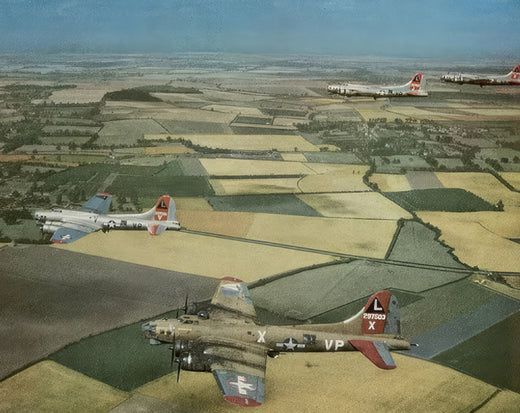This art piece by Craig Tinder portrays the B-17G Flying Fortress known as, Princess Pat as she appeared during her final flight on 25 March 1945.
Details About the RELIC:
This relic fragment was removed from B-17G-95-DL Flying Fortress, 44-83872, during a port wing spar restoration in 2001. Originally manufactured at the Douglas Aircraft Corporation in Long Beach, CA, it was delivered on July 12, 1945. The aircraft served with the U.S. Navy as a PB-1W until 1955. It became privately owned and appeared at General Curtis LeMay's retirement ceremony in 1965. After many years of restoration, the aircraft donned the livery of the 381st Bombardment Group - nearly identical to "Princess Pat" and would be known as "Texas Raiders."
Artist Craig Tinder served as a restorer and Loadmaster on B-17G 44-83872 and personally worked to replace many corroded or replaceable components, fasteners, and aluminum skins. These are among the last pieces remaining of this aircraft and include a mix of Natural Aluminum, Zinc Chromate Yellow, Black, Olive Drab, and Neutral Gray.
 Wing fragment from B-17 removed during restoration - Relics from these parts are embedded onto "Twilight's Last Crucible" limited edition canvas art
Wing fragment from B-17 removed during restoration - Relics from these parts are embedded onto "Twilight's Last Crucible" limited edition canvas art

Artist Craig Tinder with "Texas Raiders" during an airshow in 2012
The Story Behind the Print:
On 25 March 1945, Princess Pat, a B-17G Flying Fortress belonging to the 381st Bombardment Group, 533rd Bombardment Squadron (VP-X), embarked on a crucial evening test flight following an intense combat mission the day before. Piloted by Captain Charles H. "Hotrock" Carpenter, the crew aimed to verify repairs made after sustaining damage during the previous day’s operation, where Princess Pat played a key role in striking the Luftwaffe night fighter base at Twente, Holland. This strategic target was vital in disrupting the German air defense, particularly to support the Allied airborne assault during the crossing of the Rhine River, marking the final offensive push in Europe.
 Color Photo of B-17G Princess Pat (X-VP)
Color Photo of B-17G Princess Pat (X-VP)
The mission on 24 March, in which Princess Pat took part, was pivotal in hampering German air operations as the Allies prepared to initiate Operation Varsity—the massive airborne operation that would help secure the Rhine crossing. The precision bombing at the crossroads of the Twente airbase was crucial in weakening German air resistance ahead of the airborne deployment. After completing this high-stakes operation, Princess Pat required mechanical assessments and repairs, leading to the evening test flight on 25 March.
 Close up view of artist, Craig Tinder, painting "Twilight's Last Crucible"
Close up view of artist, Craig Tinder, painting "Twilight's Last Crucible"
As the crew carried out their test flight, all seemed to proceed smoothly. However, tragedy struck during the landing phase when the aircraft unexpectedly caught fire and became engulfed in flames. Despite the harrowing incident, all crew members managed to escape the inferno unharmed. Though the aircraft was lost, the survival of the crew was a small victory, a testament to their training and quick response in the face of disaster.
 Artist, Craig Tinder, with original oil painting of "Twilight's Last Crucible" - oil on canvas
Artist, Craig Tinder, with original oil painting of "Twilight's Last Crucible" - oil on canvas
To purchase or see similar items, visit here.
Commissioned by Museums, Treasured by Collectors





Share:
The P-47 Thunderbolt: An Icon of WWII Aviation
The Distinction Between the Bf 109 and the Me 109